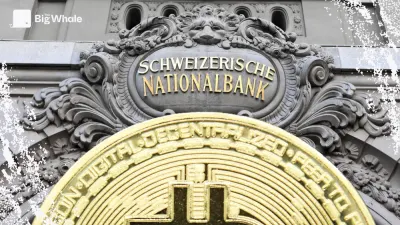TBW - Bitcoin Treasury Companies: A Guide to Financial Instruments

Driven by an unshakeable conviction about the future of Bitcoin, some companies are no longer hesitating to make it the core of their financial strategy. Starting with Strategy - the new name for MicroStrategy - a pioneer and leader in this radical approach. The American company has already invested more than 33 billion dollars in digital assets since 2020. And it has no intention of stopping there. On 30 October 2024, it unveiled an ambitious plan dubbed "21/21": to raise $42 billion over three years to finance its growth, mainly through the massive purchase of bitcoins.
This "Bitcoin Treasury Company" model, which Strategy has championed in the United States, is being emulated around the world. In Japan, Metaplanet has set itself the target of holding 10,000 bitcoins by the end of 2025, and 21,000 by 2026. In Europe, The Blockchain Group recently made its mark with an unprecedented fundraising of €46.8 million... entirely denominated in bitcoins.
For the forerunners, entry into the Bitcoin universe often begins with a reallocation of existing cash. Rather than letting their cash lie dormant in low-yielding traditional assets, some companies opt for a more aggressive strategy: converting a portion of their reserves into BTC.
This was the path taken by Strategy at the start of its programme. Between August and December, the software company acquired more than 40,000 bitcoins for $475 million, using profits from its core business. With thirty years' expertise in business intelligence, it quickly turned its profitability into a springboard into the crypto ecosystem.
But not all Bitcoin Treasury Companies have such a strong foundation. Many of them are emerging structures, or even vehicles created ex nihilo to drive an accumulation strategy.
With no recurring cash flow, they have to rely on alternative financial instruments: equity fundraising, Bitcoin-indexed bonds, strategic partnerships...
So many mechanics to initiate and perpetuate an unprecedented dynamic, at the crossroads of traditional finance and the digital economy.
%20(2).png)
Bonds: the preferred tool for financing Bitcoin accumulation
Bonds are one of the most popular financial tools available to Bitcoin Treasury Companies. Whether simple, secured or convertible debt, these securities make it possible to raise considerable amounts of capital, often from institutional investors, while giving the company valuable strategic leeway.
From the investor's point of view, these bonds offer several advantages. Their liquidity - because they can be resold on secondary markets - makes them less risky instruments than a direct loan or equity investment. Added to this is appreciable contractual flexibility: repayment terms, interest rates, collateral required... all elements that can be adjusted according to the issuer's profile, market conditions, or risk appetite.
In this environment, three major families of bonds are emerging as the pillars of the financing strategy for Bitcoin-focused companies.
👉 Plain vanilla bonds: tactical but expensive leverage
Long considered unsuitable for long-term financial strategies, so-called "plain vanilla" corporate bonds nevertheless retain a place in the arsenal of Bitcoin Treasury Companies. These traditional debt securities, redeemable exclusively in cash at maturity, are sometimes used for very targeted purposes.
In a context of still-high interest rates, their main shortcoming is obvious: a financing cost that can put a strain on the profitability of the operation over time. For this reason, they are rarely favoured to support a strategy of massive bitcoin accumulation.
But some companies are mobilising them tactically. Issuing simple bonds can act as a trial balloon, ahead of a more ambitious operation, such as raising convertible bonds. It allows investors' appetite to be tested, while meeting an immediate cash requirement.
This approach also offers a strategic advantage: waiting until the emergence of more favourable market conditions - falling interest rates, more attractive stock market valuation - to trigger a more structured, potentially less dilutive fundraising.
👉 Covered bonds: the balance between trust and control
Halfway between traditional bonds and collateralised loans (see below), covered bonds are gaining ground with crypto-friendly companies looking for more advantageous financing terms. By backing these securities with assets - financial or digital - issuers manage to reassure investors, negotiate lower interest rates and, sometimes, extend the maturity of the debt.
For creditors, the framework is reassuring. In the event of default, the assets pledged as collateral can be seized, limiting the risk of loss. This level of protection justifies a more moderate remuneration. Another advantage is the liquidity of these securities, which allows investors to exit their position on the secondary market if necessary.
But this relative security comes at a cost to the issuer. The assets pledged as collateral are frozen for the duration of the loan, exposing the company to the risk of forced liquidation in the event of financial turbulence.
To make them even more attractive, some of these bonds are also structured with a priority redemption clause. In the event of bankruptcy, the holders of these securities move to the front of the queue. A decisive argument to seduce the most cautious investors.
👉 Convertible bonds: the favourite weapon of pro-Bitcoin companies
Among the most prized financial tools of companies that use Bitcoin as their main strategic lever, convertible bonds occupy a special place. Often referred to as convertible notes, these hybrid bonds offer a dual advantage: at maturity, investors can choose between repayment in cash or conversion into shares in the company.
The principle is simple. At the time of issue, a reference price is set. If the share price exceeds this threshold, the investor can convert his debt into shares, on advantageous terms, and potentially realise a substantial capital gain. In return for this option, creditors accept interest rates that are often very low, or even symbolic, making financing inexpensive for the company.
Another major advantage: in the event of conversion, no cash outlay is required, enabling the company to preserve its cash position. A major advantage for structures looking to maximise their exposure to Bitcoin without denting their short-term financial capacity.
But the tool is not without a downside. If the capital raised is misallocated - for example, used to cover fixed costs or refinance existing debt - and does not contribute to improving the BTC yield (the growth in the number of Bitcoins per share), investors may question the relevance of the model. In a market as volatile as Bitcoin's, market confidence remains a commodity as strategic as it is fragile.
👉 The Blockchain Group inaugurates Bitcoin-denominated bonds
It's a first in the world of finance: The Blockchain Group has raised around €48.6 million via an issue of convertible bonds... mostly denominated in Bitcoin. Rather than raising euros and then buying bitcoins, the European group chose to borrow the digital asset directly. When the securities mature, the company will either have to return the borrowed bitcoins or issue new shares at a unit price of €0.544.
This innovation marks a world first for a listed company and could well pave the way for a new class of financial instruments. By eliminating the conversion stage between fiat and crypto, this type of issue facilitates the direct accumulation of bitcoins. But above all, it profoundly alters the distribution of risk: in the event of a prolonged fall in the Bitcoin price, it is the investor - and not the issuer - who bears the brunt of the volatility. If the price of BTC remains low at maturity, The Blockchain Group will be able to simply return the same bitcoins borrowed, without having to liquidate other assets, unlike what a traditional fiat currency bond would require.
A precedent that could inspire other players, in a context where the gradual institutionalisation of Bitcoin is pushing companies to explore new financing tools.
Financing your Bitcoin strategy by selling shares: a double-edged sword
To finance themselves without going into debt, many Bitcoin Treasury Companies are relying on a simple, straightforward method: issuing new shares. This is a strategic choice to avoid the burden of interest, the risk of default and the uncertainty associated with converting debt into equity. Unlike convertible bonds, raising funds through capital increases dilutes existing shareholders more quickly. It is therefore imperative that they generate a higher return on Bitcoin held (BTC yield) than an investor could obtain by holding BTC directly. Otherwise, shareholders suffer a double penalty: a relative loss on the value of their stake and an obvious opportunity cost.
Several mechanisms are used to carry out these operations:
👉Share offers
In this case, the company issues new shares that it sells off in a block, either via a public offering or as part of a private placement aimed at institutional investors. These operations, often carried out in response to an immediate need for cash, have the disadvantage of introducing brutal dilution for existing shareholders, as well as increased selling pressure on the share in the short term.
👉 "At-the-market" sales: a flexible but potentially dilutive financing tool
Popular in the United States, "at-the-market" sales (or ATM sales) are a progressive financing mechanism for listed companies. The principle is simple: rather than raising funds all at once, the company issues new shares as it goes along, depending on market conditions, via partner brokers.
This modus operandi has several advantages. It is less brutal for the market than a traditional fundraising, which is often perceived as dilutive. By spreading the issues over time, the company avoids a sudden fall in its share price. But this relative discretion has a downside: it maintains latent selling pressure, likely to dissuade certain institutional or retail investors, put off by the lack of visibility.
The strategic interest of ATM sales is particularly salient during periods of stock market euphoria. When the share price soars far beyond the company's intrinsic value - a common phenomenon for companies holding massive amounts of bitcoin - these sales help to correct the situation. By gradually injecting new shares into the market, the company mechanically reduces its premium while strengthening its cash position, often with the aim of further increasing its BTC reserves.
Outside the United States, this type of flexibility remains more limited. In Europe and Asia, companies have to turn to other instruments - share options, warrants (BSAs), or share acquisition rights. Less nimble than ATM sales, these tools can nevertheless be used to structure staggered fundraising, thanks to rights issues that can be activated over defined periods.
👉 Preferred Stocks
Strategy is adding a new string to its bow to finance its bitcoin accumulation strategy: preferred stocks. Michael Saylor's company recently launched two new financial securities, STRK and STRF, which move away from the traditional ordinary share model, while opening the door to a new class of investors, more institutional and risk-averse.
In contrast to traditional MSTR shares, which give access to voting rights, a share of the capital and direct exposure to market volatility, preferred shares offer a fixed return and contractual guarantees. STRK, introduced in 2024, does not carry voting rights, but entitles holders to an annual dividend of 8%, paid quarterly in cash or MSTRs, subject to approval by the Board of Directors. These dividends are cumulative: in the event of non-payment, they accumulate and remain payable. Each STRK share is also convertible into 10 MSTR shares, provided that the MSTR share price exceeds USD 1,000. In the event of the company's liquidation, STRK is repaid up to 100 dollars, a clause written into the contract that positions this security between a convertible bond and an ordinary share in terms of priority.
STRF, announced on 18 March 2025, follows the same logic as STRK with a few major differences. It offers a higher annual return of 10%, but paid exclusively in cash. It also ranks higher than STRK in the hierarchy of creditors, which strengthens its guarantees. On the other hand, it does not provide for any possibility of conversion into MSTR or STRK, making it a pure yield product, with no capital exposure.
These hybrid securities, halfway between equities and bonds, aim to broaden Strategy's investor base, particularly towards institutional profiles. With a fixed yield and a guaranteed redemption value, they offer an attractive alternative to those wishing to gain exposure to Michael Saylor's bitcoin strategy without suffering from its volatility. In particular, Strategy plans to raise up to $21 billion via "ATM" sales with STRK stock alone.
For Strategy, the challenge is twofold: to continue funding bitcoin purchases without immediately diluting MSTR shareholders, and to buy time before a potential mass conversion of preference shares. While STRK's dividends can be paid in MSTR shares, full conversion into ordinary shares will only take place if the share price exceeds the symbolic threshold of $1,000, which limits the dilutive pressure in the short term.
This financial engineering does have a downside, however. By multiplying the number of financial instruments - ordinary shares, convertible bonds, STRK, STRF - Strategy adds complexity to a capital structure that is already difficult for many investors to understand. It is also increasing its dependence on fixed cash commitments, particularly for STRF cash dividends, while further segmenting its available resources.
These preference shares thus appear to be a new tool in Michael Saylor's toolkit: they allow him to continue buying bitcoin on a massive scale, while reassuring the most cautious investors. But they also add a layer of complexity and risk to a company whose financial structure is constantly moving away from traditional standards.
Collateralised borrowing: a tool ill-suited to a long-term strategy
Often associated with the DeFi ecosystem, collateralised borrowing appears in the collective imagination as an obvious lever for financing the accumulation of bitcoins. In practice, however, this instrument remains marginal in the strategy of Bitcoin Treasury Companies.
The principle is simple: obtain financing by pledging an asset as collateral - in this case, Bitcoin - with a bank or specialist institution. This was the route taken by Michael Saylor in 2022, when he took out a $205 million loan with Silvergate Bank. To secure this financing, the entrepreneur deposited some $820 million in BTC as collateral, with an interest rate of 3.75%.
This operation made it possible to raise funds quickly without diluting the company's capital, a strategic choice to preserve shareholder value. Theoretically, a rise in Bitcoin could even have enabled the loan to be repaid while generating a significant capital gain.
But the timing was unfavourable: the market was entering a turbulent zone, initiating a brutal bear market. The fall in the Bitcoin price exposed the flaws in this mechanism. The particularly conservative loan-to-value (LTV) ratio - only 25% in the case of Strategy - meant that the company had to mobilise its reserves on a massive scale to guarantee the loan. After FTX collapsed in November 2022, the firm had to inject additional bitcoins to meet a margin call, highlighting the fragility of such an arrangement in a highly volatile environment.
While the collateralised loan offers a solution without diluting capital, it is proving to be of little relevance to a long-term asset strategy. It requires high guarantees, significant interest rates and, above all, exposure to the risk of liquidation in the event of a market downturn. A luxury that few Bitcoin Treasuries can afford.
>> Attend our event dedicated to Bitcoin Treasury Companies in Paris



